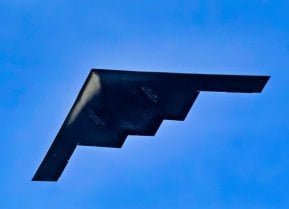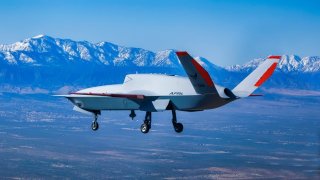XQ-67A: The U.S. Air Force's New Loyal Wingman Drone Has Arrived
The U.S. Air Force Research Laboratory's (AFRL) experimental drone, the XQ-67A, successfully completed its maiden flight at the General Atomics Gray Butte Flight Operations Facility near Palmdale, California.
Summary: The U.S. Air Force Research Laboratory's (AFRL) experimental drone, the XQ-67A, successfully completed its maiden flight at the General Atomics Gray Butte Flight Operations Facility near Palmdale, California. Developed under the Off-Board Sensing Station program by General Atomics Aeronautical Systems, the XQ-67A is designed to act as a loyal wingman for manned aircraft, extending their sensory capabilities. It represents a new approach to aircraft design, utilizing a common chassis to streamline production and reduce costs. This method promises rapid development of various unmanned aerial vehicles, enhancing the U.S. military's ability to adapt to changing threats and technological advancements.
AFRL's XQ-67A Drone Embarks on Its First Flight, Revolutionizing Airforce Capabilities
The U.S. Air Force Research Laboratory's (AFRL’s) Aerospace Systems Directorate successfully conducted a test flight of the XQ-67A, an off-board sensing station. The uncrewed air vehicle was tested last week at the General Atomics Gray Butte Flight Operations Facility near Palmdale, California.
The XQ-67A made its maiden flight on Feb. 28, just one year after the AFRL selected General Atomics Aeronautical Systems (GA-ASI) to build the vehicle under the Off-Board Sensing Station program. The project called for the development of an unmanned aerial vehicle that could fly ahead of manned aircraft, acting as a type of loyal wingman that could transmit data back to the aircraft, thus extending its ability to detect and track targets.
"OBSS is the first aircraft type built and flown using a common core chassis developed by GA-ASI that promotes commonality across multiple vehicle types," Michael Atwood, GA-ASI’s vice president of advanced programs, told Janes.
The XQ-67A has been described as the first exemplar in a second generation of autonomous collaborative platforms. It follows the success of the XQ-58A Valkyrie, the first low-cost uncrewed air vehicle intended to provide the warfighter with credible and affordable mass.
The XQ-67A further cements the value of using a common chassis – the “genus” approach to aircraft design.
"This approach will help save time and money by leveraging standard substructures and subsystems, similar to how the automotive industry builds a product line," said Doug Meador, AFRL's autonomous collaborative platform capability leader. "From there, the genus can be built upon for other aircraft – similar to that of a vehicle frame – with the possibility of adding different aircraft kits to the frame, such as an Off-Board Sensing Station or Off-Board Weapon Station."
This approach allows a template for numerous aircraft "species" to be rapidly generated on a standard genus chassis. It seeks to address the challenges of great power competition by speeding the delivery of affordable, advanced capabilities to the warfighter.
XQ-67A: More Than Reconnaissance
The XQ-67 is the first variant to be designed and built from this shared platform. While the recent tests have focused on how well the XQ-67A transmits data on potential adversary targets, it could be adapted to perform other roles.
According to Interesting Engineering, variants are likely to be developed to serve as platforms for experimentation and evaluation by test pilots and operations planners. Future versions could be designed to act as attributable loyal wingmen, acting under the guidance of pilots or autonomous systems, much like the MQ-28A "Ghost Bat" currently in development by Boeing.
Additionally, the XQ-67A could signal to other aerospace firms a new approach to constructing an aircraft. The conventional method of starting from scratch might give way to building aircraft from a chassis.
"This is all part of a bigger plan and it's all about this affordable mass," Meador added. "This has to be done affordably and this program even though there's an aircraft at the end that we're going to get a lot of use out of the purpose of this program was the journey of rapid, low-cost production as much as it was the destination of a relevant combat aircraft."
Author Experience and Expertise: Peter Suciu
Peter Suciu is a Michigan-based writer. He has contributed to more than four dozen magazines, newspapers, and websites with over 3,200 published pieces over a twenty-year career in journalism. He regularly writes about military hardware, firearms history, cybersecurity, politics, and international affairs. Peter is also a Contributing Writer for Forbes and Clearance Jobs. You can follow him on Twitter: @PeterSuciu. You can email the author: [email protected].


